
Sphaerius is a genus of beetles, comprising 23 species, which are the only living members of the family Sphaeriusidae. They are typically found along the edges of streams and rivers, where they feed on algae; they occur on all continents except Antarctica. Three species occur in the United States.

Scolymus is a genus of annual, biennial or perennial, herbaceous plants that is assigned to the Daisy family, and can be found in Macaronesia, around the Mediterranean, and in the Middle East. All species are spiny, thistle-like in appearance, with flowerheads that consist of yellow ligulate florets, and canals that contain latex. It is known as سكوليمس (skwlyms) in Arab, scolyme in French, and is sometimes called golden thistle or oyster thistle in English.

Scolymus hispanicus, the common golden thistle or Spanish oyster thistle, is a flowering plant in the genus Scolymus in the family Asteraceae, native to southern and western Europe, north to northwestern France.
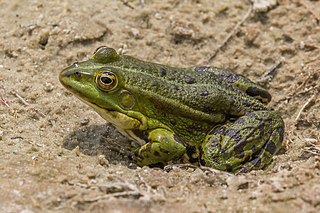
The marsh frog is a species of water frog native to Europe and parts of western Asia.
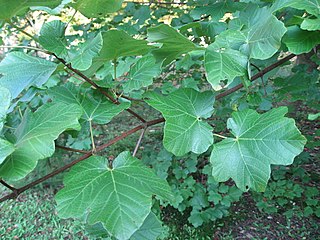
Acer opalus, the Italian maple, is a species of maple native to the hills and mountains of southern and western Europe, from Italy to Spain and north to southern Germany, and also in northwest Africa in Morocco and Algeria.
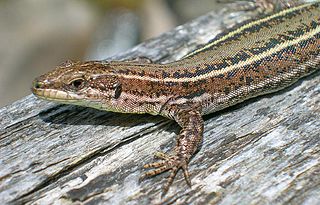
Podarcis hispanicus, also known as Iberian wall lizard, is a small wall lizard species of the genus Podarcis. It is found in the Iberian peninsula, in northwestern Africa and in coastal districts in Languedoc-Roussillon in France. In Spanish, this lizard is commonly called lagartija Ibérica.
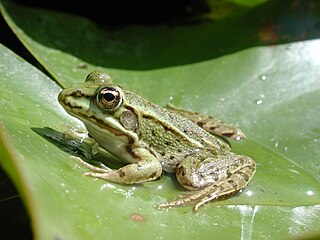
The Italian edible frog is a hybridogenic species in the true frog family Ranidae. These frogs are the offspring of P. bergeri and either P. ridibundus or the edible frog which is itself of hybrid origin.

Psammodromus hispanicus, the Spanish psammodromus, is a species of lizard in the family Lacertidae. It is found in France, Portugal, and Spain. Its natural habitats are Mediterranean-type shrubby vegetation, temperate grassland, sandy shores, arable land, pastureland, and rural gardens. It is threatened by habitat loss.

Allognathus is a genus of air-breathing land snails, terrestrial pulmonate gastropod mollusks in the family Helicidae, the true snails. The genus is endemic to the Balearic Islands being present in all major islands and in several small islets. The genus colonized the archipelago from the south-eastern Iberian Peninsula during the Middle Miocene, throughout a land-bridge connection. The different species belonging to Allognathus live in crevice rocks or under stones.
Phoberocyon is a large extinct genus of hemicyonine bear, found primarily in North America during the Miocene. It lived from 28.4—13.7 mya, existing for approximately 14 million years. One species, P. hispanicus, is known from Miocene Spain.

A loline alkaloid is a member of the 1-aminopyrrolizidines, which are bioactive natural products with several distinct biological and chemical features. The lolines are insecticidal and insect-deterrent compounds that are produced in grasses infected by endophytic fungal symbionts of the genus Epichloë. Lolines increase resistance of endophyte-infected grasses to insect herbivores, and may also protect the infected plants from environmental stresses such as drought and spatial competition. They are alkaloids, organic compounds containing basic nitrogen atoms. The basic chemical structure of the lolines comprises a saturated pyrrolizidine ring, a primary amine at the C-1 carbon, and an internal ether bridge—a hallmark feature of the lolines, which is uncommon in organic compounds—joining two distant ring carbons. Different substituents at the C-1 amine, such as methyl, formyl, and acetyl groups, yield loline species that have variable bioactivity against insects. Besides endophyte–grass symbionts, loline alkaloids have also been identified in some other plant species; namely, Adenocarpus species and Argyreia mollis.

Adenocarpus is a genus of flowering plants in the family Fabaceae. It belongs to the subfamily Faboideae. The plants are broom-like shrubs with bright yellow flowers. The genus is native to Macaronesia, Portugal and southern Spain, and three species are endemic to the western Canary islands where they are known by the common name Codeso.
Phyllonorycter adenocarpi is a moth of the family Gracillariidae. It is known from the Iberian Peninsula.
Coleophora calycotomella is a moth of the family Coleophoridae. It is found from the Netherlands and Germany to the Iberian Peninsula, Sardinia, Sicily and Crete.
Mirificarma cabezella is a moth of the family Gelechiidae. It is found in Portugal, Spain and Morocco.

Adenocarpus decorticans, also known as silver broom, is a species of flowering plant in the Faboideae subfamily which is endemic to the Sierra Nevada in Spain. The species have lemon-coloured flowers.
Adenocarpus foliolosus, known locally as codeso and commonly known as Canary Island flatpod is a shrubby species of flowering plant in the legume family Fabaceae, subfamily Faboideae, that is endemic to Canary Islands where it can be found in Tenerife, La Gomera, El Hierro, Gran Canaria and La Palma. It has yellow flowers, a narrow, oblong legume with sparse glands, compound leaves and short petioles 1–3 millimetres (0.039–0.118 in) long.
Adenocarpus ombriosus is a species of flowering plant in the Faboideae subfamily that is endemic to El Hierro of the Canary Islands, where it can be found on the elevation of 500 metres (1,600 ft) and 1.400 metres.

Narcissus hispanicus, the Spanish daffodil, or great daffodil, is a plant species native to France, Spain and Portugal. It is naturalized in the United Kingdom and cultivated elsewhere.
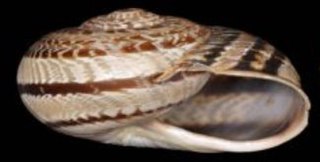
Allognathus hispanicus is a species of land snail in the family Helicidae, the true snails. This species is endemic to Mallorca, one of Spain's Balearic Islands. The common name is "caragol de Serp", due to the pattern of it shell.














